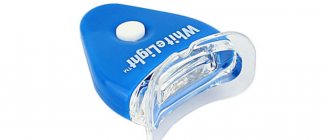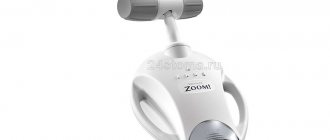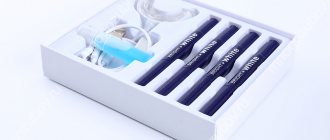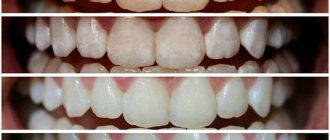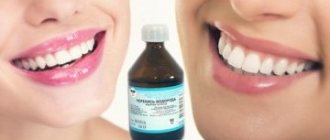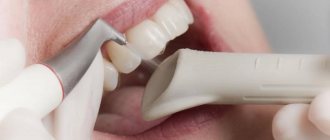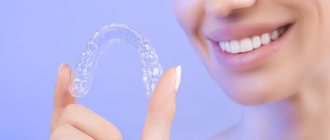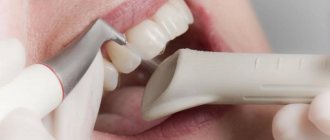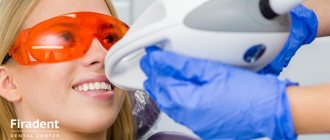Teeth are constantly stained due to drinking coffee, tea, smoking, drinking alcohol, and drinking sweet soda. In addition, the color of teeth is also affected by the environment and consumption of food with dyes. Gradually, teeth become yellower, even if you use whitening pastes for cleaning and constant care. Fortunately, modern dentistry allows you to get rid of the yellow tint using several methods.
Teeth whitening is one of the most popular procedures in modern dentistry. The owner of a beautiful smile feels more comfortable in company, is ready to smile and not be embarrassed by the color of his teeth. White teeth instantly attract attention and increase a person’s status. Not only actors, artists and businessmen, but also “ordinary people” whiten their teeth. This helps you advance in your career, work more successfully with people, and find a common language with management.
The most common question from our patients is: does teeth whitening hurt?
Teeth whitening in dentistry
It seems to modern people that snow-white teeth have always been an integral attribute of an attractive appearance, but this is far from the case. During the Roman Empire, wearing gold dentures was considered a blessing—a symbol of power and prosperity (by the way, in Russia, gold crowns once played the same role). The aristocracy of the Middle Ages was proud of rotten teeth - a sign of high origin and wealth. In Ancient China, things were no better: women deliberately made their smile black in order to please the future groom. Of course, darkened teeth were not held in high esteem everywhere and not at all times, and there were people who were looking for more and more new means for whitening them.
Teeth whitening methods
All types of teeth whitening can be divided into professional and non-professional. The first ones are carried out by a doctor in a clinic or by the patient himself at home under the supervision of a doctor. These include methods such as photobleaching, laser, chemical bleaching, endobleaching and home whitening using caps. Each of the listed methods of teeth whitening has its own pros and cons, indications and contraindications.
The second group includes various whitening products that can be purchased freely and used independently without the participation of a specialist. We are talking, first of all, about whitening pastes. Non-professional whitening includes special whitening plates, pencils and systems with universal trays, but doctors still do not recommend using them yourself, since careless use of such products can lead to complications such as sharp pain during whitening and increased tooth sensitivity after it.
How to keep your teeth white longer
Depending on the technique used, the effect of professional whitening can last for more than one year. However, some patients return to the clinic after a few months for a repeat procedure. To ensure that your smile remains dazzling for a long time, doctors recommend adhering to the following rules:
- do not eat for 3 hours after teeth whitening, you can only drink clean water, then you must adhere to a special diet;
- Do not use a brush with hard bristles, as this will only increase sensitivity;
- purchase a paste without abrasive particles;
- rinse your mouth, use dental floss, and irrigator after each meal;
- Mouth rinses should not contain chlorhexidine (it stains teeth);
- follow a schedule of visits to the dentist for preventive examinations (at least once every six months);
- complete smoking cessation for 2-3 days, preferably for several weeks.
Special diet
To maintain the effect for a long time immediately after the procedure, you must adhere to a special diet. It is important to minimize the consumption of foods with bright colors. It is advisable to eat:
- porridge;
- dairy (but not fermented milk) products;
- fish and seafood;
- chicken, rabbit;
- egg white;
- white fruits and vegetables (such as bananas).
Along with eliminating food containing dyes from the diet, it is recommended to avoid coloring spices. This is turmeric, paprika. Dentists also do not advise eating smoked meats, citrus fruits, any berries, drinking coffee, black tea and alcoholic beverages.
Effective teeth whitening
Before the patient agrees to whitening, the doctor must warn that the results may be disappointing. This is especially true for complex cases, such as teeth with fluorosis. In addition, the patient should be warned about the possible replacement of old restorations. Whitening of fillings, crowns, veneers or implants is not possible.
The most effective methods of teeth whitening are professional techniques. The leading place in terms of effectiveness is occupied by laser whitening, which to some extent can even cope with tetracycline teeth. Then comes photobleaching - the most famous and popular in-office technique today. Closing the top three is the chemical technique, which is used very rarely, but definitely deserves attention. Home professional whitening is also quite effective, but to get results you need to take a fairly long course.
As for non-professional whitening systems, the most effective of them are those that contain hydrogen peroxide or carbamide peroxide. All other products without the listed active whitening substances have only a good cleaning effect from plaque and polishing the tooth surface.
If we talk about the effectiveness of whitening in general, then, even when using the same product, different patients will have different results. The best and fastest effect is achieved by whitening teeth with natural yellowish tints; teeth with grayish shades are less bleached. And although everything depends on the specific case, to say that the effect of the procedure is completely unpredictable is also wrong. A dentist who has good practice can predict the outcome in simple clinical cases.
How is the procedure performed?
Consultation with a dentist
Analysis of the condition of enamel and dentin
Professional cleaning
Removal of all deposits, including tartar
Laser teeth treatment
With application and removal of special gel
A special gel-like composition is applied to the tooth enamel. Under the action of a laser beam, the active substance is released, penetrates deeply into the enamel and removes stubborn pigments that worsen the color.
All necessary manipulations take on average about 1.5 hours. At the same time, one procedure provides lightening of 6-8 shades even in the most complex cases of enamel pigmentation.
Composition of whitening gels
For various methods of professional and non-professional teeth whitening, special whitening gels are used, the active substances of which are hydrogen peroxide or carbamide. Sometimes the preparations include amorphous calcium phosphate, fluoride or potassium nitrate to treat minor damage to the enamel, as well as to make teeth brighter and glossier after the procedure. In some cases, the whitening gel may contain special components that have a soothing effect on the teeth and gums.
Zoom 4 – safe whitening mechanism
Initially, using a special scale, the doctor determines the existing color shade of the tooth enamel. The next step is protective treatment of the oral cavity. Finally, the initial application of the whitening composition to the front teeth (5 upper and 5 lower) occurs. After this, a hardware targeted effect occurs on the treated teeth using a lamp that produces ultraviolet radiation for 10-15 minutes. The protective treatment of the soft tissues of the mouth mentioned earlier is intended for this purpose. Special glasses are used to protect the patient's eyes. Then the gel is applied two more times and the procedure is repeated. Thus, the time spent at the dentist is no more than one hour.
One session will allow you to enjoy a charming smile for more than one year, and, compared to the previous generation, with Zoom 4 the effect lasts up to 25 percent longer (up to 7 years, subject to strict adherence to the doctor’s recommendations).
Teeth whitening procedure
In the whitening procedure, it is very important to strictly follow its protocol.
- Before you start whitening your teeth, you need to conduct a diagnosis: find out the reason for the change in the color of the tooth enamel, take an x-ray, examine the gums and check the condition of the teeth. Based on the data obtained, the doctor selects the whitening system that is most suitable in this case.
- This is followed by mandatory professional teeth cleaning.
- Before and after the whitening procedure, remineralization therapy is performed.
- Rapid in-office teeth whitening is performed in the clinic directly by a dental hygienist. A gel with a whitening agent concentration of at least 30% is applied to the teeth, which is activated by light, laser, or acts on its own. The duration of the procedure depends on the specific technique, but, as a rule, only one visit is required. For home whitening in dentistry, individual trays are made, and a suitable whitening gel is selected. The patient carries out the procedure itself at home, following the doctor’s recommendations. The gel is applied to trays, which are placed on the teeth and worn once or twice a day or left overnight, depending on the teeth whitening technology. The course can last from two weeks to a month.
- At the end of the procedure, the result obtained is assessed using the VITA scale.
Important!
After teeth whitening, you should not smoke, drink red wine or coffee, or consume any foods with strong coloring pigments, such as red berries and beets.
The effect of white teeth can last from six months to several years. It is very difficult to say exactly how long teeth whitening will last, since it depends on many factors. To maintain long-term results, it is recommended to use maintenance whitening products for home use - pastes or rinses, as well as adhere to a transparent diet. In addition, good oral care and regular professional cleanings can also help maintain a snow-white smile for a long time. It is likely that sooner or later the procedure will have to be repeated, but according to many experts, the original color of the teeth will not return.
Do it yourself or dentistry at home
It would seem that it has long been clear that procedures related to one’s own health are best left to professionals. After all, in the end, going to a doctor will be the most economical way both in terms of time and costs. Self-medication, at a minimum, does not lead to the desired results, and in the worst case scenario, it creates new problems, the elimination of which will require both time and money.
To whiten teeth at home, specialized toothpastes are used, as well as whitening strips and pencils. However, in most cases, the effect of use is minimal or absent altogether. The reasons for this lie in the fact that the recommendations for the use of these products specified in the accompanying manuals do not take into account many factors - such as age, dental condition, the presence of dental defects or chronic diseases, as well as inflammatory processes. Not to mention that many people prefer not to read any instructions at all. The result can be disastrous - without solving one problem, you will acquire new ones in the form of specific complications.
Even if you carefully follow all the instructions, avoid products that promise a miracle effect in just a day or hour. Such technologies simply do not exist! The trick of some unscrupulous manufacturers may come down to the inclusion of a dye in the composition. As a result, your teeth will actually turn white for a short time, but after the first brushing or a couple of meals, all the whiteness will quickly disappear.
In a situation where the problem is not so significant, the most reasonable action would be to consult a dentist, who will be able to prescribe medications for home use in accordance with an individually developed program. In more complex cases, whitening should be done in the dentist's office.
Complications after teeth whitening
The most common problem that patients encounter after whitening is increased tooth sensitivity. The cause of painful sensations is the process as a result of which the teeth, under the influence of the whitening gel, lose moisture and are then re-saturated with liquid. Remineralizing therapy before the procedure and the use of special medications help neutralize pain after teeth whitening. Increased tooth sensitivity can also be relieved by taking painkillers.
Indications and contraindications
The main indication for laser teeth whitening is darkening of the enamel and its unaesthetic tint!
This procedure has a minimum of contraindications:
- pregnancy;
- individual intolerance to the components of the gel;
- fluorosis;
- age up to 16 years.
Since modern laser technologies make it possible to select the most accurate parameters for the intensity and duration of the beam in each clinical case, the possibility of thermal damage to dental tissues and gums or the occurrence of discomfort during the procedure is completely excluded.
